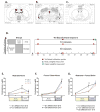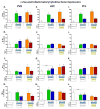Repeated exposure to two stressors in sequence demonstrates that corticosterone and paraventricular nucleus of the hypothalamus interleukin-1β responses habituate independently
- PMID: 28803453
- PMCID: PMC5617797
- DOI: 10.1111/jne.12514
Repeated exposure to two stressors in sequence demonstrates that corticosterone and paraventricular nucleus of the hypothalamus interleukin-1β responses habituate independently
Abstract
A wide range of stress-related pathologies such as post-traumatic stress disorder are considered to arise from aberrant or maladaptive forms of stress adaptation. The hypothalamic-pituitary-adrenal (HPA) axis readily adapts to repeated stressor exposure, yet little is known about adaptation in neuroimmune responses to repeated or sequential stress challenges. In Experiment 1, rats were exposed to 10 days of restraint alone (60 minutes daily), forced swim alone (30 minutes daily) or daily sequential exposure to restraint (60 minutes) followed immediately by forced swim (30 minutes), termed sequential stress exposure. Habituation of the corticosterone (CORT) response occurred to restraint by 5 days and swim at 10 days, whereas rats exposed to sequential stress exposure failed to display habituation to the combined challenge. Experiment 2 compared 1 or 5 days of forced swim with sequential stress exposure and examined how each affected expression of several neuroimmune and cellular activation genes in the paraventricular nucleus of the hypothalamus (PVN), prefrontal cortex (PFC) and hippocampus (HPC). Sequential exposure to restraint and swim increased interleukin (IL)-1β in the PVN, an effect that was attenuated after 5 days. Sequential stress exposure also elicited IL-6 and tumour necrosis factor-α responses in the HPC and PFC, respectively, which did not habituate after 5 days. Experiment 3 tested whether prior habituation to restraint (5 days) would alter the IL-1β response evoked by swim exposure imposed immediately after the sixth day of restraint. Surprisingly, a history of repeated exposure to restraint attenuated the PVN IL-1β response after swim in comparison to acutely-exposed subjects despite an equivalent CORT response. Overall, these findings suggest that habituation of neuroimmune responses to stress proceeds: (i) independent of HPA axis habituation; (ii) likely requires more daily sessions of stress to develop; and (iii) IL-1β displays a greater tendency to habituate after repeated stress challenges compared to other stress-reactive cytokines.
Keywords: corticosterone; habituation; interleukin-1; multimodal stress; sequential stress.
© 2017 British Society for Neuroendocrinology.
Figures



References
-
- Dallman MF, Pecoraro NC, la Fleur SE. Chronic stress and comfort foods: self-medication and abdominal obesity. Brain Behav Immun. 2005;19:275–280. - PubMed
-
- Martí O, Martí J, Armario A. Effects of chronic stress on food intake in rats: influence of stressor intensity and duration of daily exposure. Physiol Behav. 1994;55:747–753. - PubMed
-
- Herman JP, Cullinan WE. Neurocircuitry of stress: central control of the hypothalamo–pituitary–adrenocortical axis. Trends Neurosci. 1997;20:78–84. - PubMed
-
- Goshen I, Yirmiya R. Interleukin-1 (IL-1): a central regulator of stress responses. Front Neuroendocrin. 2009;30:30–45. - PubMed
Publication types
MeSH terms
Substances
Associated data
- Actions
- Actions
- Actions
- Actions
- Actions
- Actions
- Actions
- Actions
- Actions
Grants and funding
LinkOut - more resources
Full Text Sources
Other Literature Sources
Medical
Miscellaneous

